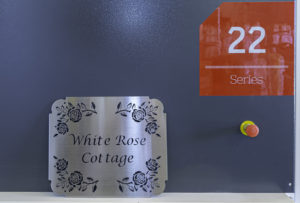Manufacturing a range of standard and bespoke beds is a labour intensive process that includes welding, fabrication, assembly, painting and coating. All of this is undertaken in-house at the Wrought Iron and Brass Bed company, whose manufacturing facility is located in Wolferton on the Sandringham Estate in Norfolk. However, increased demand put pressure on production and the need to automate certain processes became inevitable. Technical Director, Jack Thompson turned to Ellesco for a solution.

The Wrought Iron and Brass Bed company is a family-owned business that has been trading since 2003, in that time it has developed a range of standard bed frames that can be supplied ‘as is’ or customised to suit individual requirements, who are not only human as a range of dog beds are also available. Success in selling to individuals and leading high street retailers saw business boom and Jack, who was previously a development engineer with a major pharmaceutical packaging company joined his parents and brother in the business to oversee manufacturing of standard and bespoke products. These projects include one to supply 12 super king sized beds for a private residence in London as well as a one-off canopy bed for a famous playwright. With these successes and as part of a long term development plan, manufacturing was concentrated under one roof three years ago and the focus turned to streamlining production.
All of the Wrought Iron and Brass Bed Company’s products are made to order, so production is a mix of parts with relatively low volumes, with control of the process from order to delivery of the finished product undertaken in-house. Part of that process includes deburring of individual component parts for each bed and, where required creating a brush finish prior to coating for specific parts. This was a process that was undertaken manually and would take a full week to fully prepare a complete set of components by hand. The installation of a Timesavers 22 series dry finishing and deburring machine by Ellesco has reduced the time required to a single day. “The Timesavers machine has given us major time savings on what was an extremely labour intensive process. We have freed up people to work on other things,” says Jack Thompson. “As we develop the business the Timesavers machine will also be a great asset in deburring flat sheet products.”

The Timesavers 22 Series is a versatile machine that can be supplied in three widths, 900 mm, 1050, mm and 1280 mm and can be equipped with a wide abrasive belt for removing heavy burrs or a ScotchBrite belt for a brushed finish, as is the case at The Wrought Iron and Brass Bed Company, or as well as a belt it can be equipped with a rotary brush head for deburring punched parts, removing the secondary burrs and edge rounding. Depending on the finish required it is a quick process to change over the abrasive belts on the Timesavers 22 Series and one that The Wrought Iron and Brass Bed company makes full use of, utilising belts with grit sizes ranging from 80 to 400, depending on what material or style of finish is being processed. Another feature of this particular installation is the fact that Timesavers reversed the machine to make it effectively left-handed. This was required as the plan is to integrate the 22 Series machine into a flow line that will eventually include a waterjet machine.
While bed manufacture remains central to the company’s development the increased efficiency and capacity created by the addition of the Timesavers machine is allowing expansion into other areas, with gazebos and garden sculptures now available. “The plan is to have a standard range of these products, made from section material or flat sheet, but we have the flexibility and capability to design and manufacture to offer a bespoke service. The Timesavers machine will be a big advantage here as we can process flat sheet quickly, creating a brushed finish and round off corners on all edges. This corner rounding is vital both in terms of health and safety for customers, but also a precise corner is essential in the coating process to ensure good adherence to the material,” says Jack Thompson.





